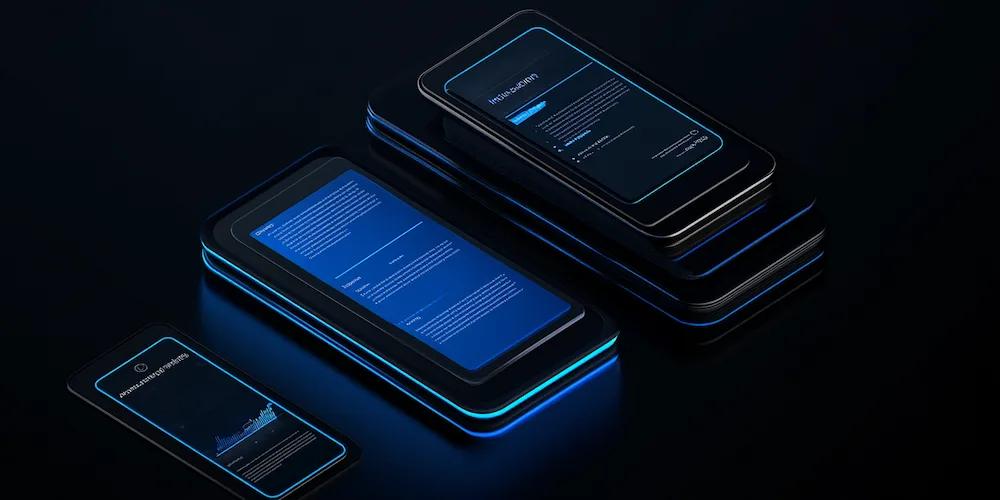57% of users won't recommend a business with a poorly designed mobile site. And the cornerstone of every user experience is the navigation.
Taking time and effort to create as best possible navigation and menu experience is especially important for mobile devices. Let's look into some of the best practices for mobile menu design.
Taking time and effort to create the best possible navigation and menu experience is especially important for mobile devices. Mobile navigation represents the first critical decision point in your website's conversion architecture. For B2B SaaS companies, where buyer journeys often span weeks and involve multiple stakeholders across devices, a poorly designed mobile menu creates abandonment points at every stage of the funnel.
The challenge intensifies for enterprise software companies managing complex information architectures. Your mobile menu must simultaneously serve technical evaluators researching specific capabilities, executives seeking high-level validation, and procurement teams comparing pricing models, all within thumb's reach on a 6-inch screen.
In brief:
- A well-designed mobile menu enhances user experience and engagement.
- Best practices for mobile menu design recommend prioritizing content, ensuring thumb-friendly interactions, and maintaining consistency across platforms.
- Accessibility consideration emphasize designing menus that are accessible to all users, including those with disabilities.

3 Most Common Types of Mobile Navigation Menus
Choosing the right mobile navigation pattern requires matching interaction models to your specific user journeys and content complexity. B2B SaaS sites typically manage deeper information architectures than consumer apps, with navigation systems that must accommodate product suites, industry solutions, resource libraries, and conversion pathways simultaneously.
The three dominant patterns below represent different trade-offs between screen real estate, discoverability, and interaction efficiency. Your choice should reflect your site's information density, your audience's technical sophistication, and your conversion goals.
Hamburger Menu
The hamburger menu is a popular choice for an effective navigation menu. It features a three-line icon that, when tapped, reveals a hidden menu. This design keeps the interface clean and uncluttered.
Pros:
- Saves screen space by hiding the menu until needed.
- Familiar to most users, making it easy to understand.
- Can accommodate many menu items without overwhelming the user.
Cons:
- Low discoverability; some users may not notice the menu.
- Requires extra taps to access menu items, which can be inconvenient.
- Can hide important navigation options, reducing their visibility.
While the hamburger menu maximizes flexibility for complex navigation structures, its hidden-by-default nature creates challenges for conversion-focused websites. The elements most critical to pipeline generation (demo Call-to-Actions (CTAs), pricing pages, contact forms) become less discoverable. This visibility problem becomes acute for B2B sites where prospects need constant access to evaluation resources throughout their journey.
Tab Bar Navigation
Tab bar navigation places icons and labels at the bottom of the screen, allowing users to switch between different sections of the app with a single tap. This method is straightforward and efficient.
Pros:
- Simple to implement
- Familiar to users
Cons:
- Could end up in clutter
Tab bars excel at surfacing 3-5 primary destinations but break down quickly when forced to accommodate the breadth of content typical in B2B SaaS sites. Gestures work well in consumer apps where users invest time learning interaction models, but B2B buyers conducting rapid competitive evaluations rarely have patience for non-standard navigation paradigms.
Gesture-Based Navigation
Gesture-based navigation relies on swipes, taps, and other gestures to navigate through the app. This method can create a more immersive and intuitive experience.
Pros:
- Simple to use
- Intuitive
Cons:
- Could provide inconsistent User Experience (UX) across different devices
The reality for most B2B SaaS sites is that no single pattern satisfies all requirements. Effective mobile navigation typically combines approaches: a hamburger menu for comprehensive site structure, persistent bottom-bar CTAs for conversion actions, and contextual navigation within specific flows.
5 Best Practices for Mobile Menu Design
Mobile menu design for B2B SaaS sites must balance the need to expose deep product information against severe screen real estate constraints. The following practices establish a framework for making strategic trade-offs that prioritize conversion velocity without sacrificing content accessibility.
1. Prioritize Content and Simplifying Navigation
When designing your mobile menu, prioritize the most important content. Users should find the key sections of your app or website quickly. Place primary navigation options at the top of the menu and use clear, concise labels.
Avoid clutter by limiting the number of menu items. Group related items under expandable sections to keep the interface clean and organized. Simplifying navigation reduces user frustration and helps them achieve their goals faster.
Content prioritization establishes the hierarchy, but execution quality determines whether users can actually interact with that hierarchy effectively. The physical constraints of mobile interaction (thumb reach zones, tap target sizing, visual feedback) create requirements that no amount of strategic thinking can overcome.
2. Design for Thumb-Friendly Interactions
Designing for thumb-friendly interactions is crucial for mobile usability. Most users hold their phones with one hand, using their thumbs to navigate. Place interactive elements within easy reach, typically the lower half of the screen.
Buttons and links should be large enough to tap comfortably without precision. Avoid placing critical actions in hard-to-reach areas. This approach ensures users can navigate your app or website effortlessly, enhancing their overall experience.
Physical usability establishes the baseline for effective interaction, but consistency across platforms determines whether users can transfer learned behaviors as they move between devices throughout their evaluation journey. B2B buyers rarely complete entire purchase cycles on a single device. Inconsistent navigation patterns force users to relearn your interface with each context switch, creating friction at every transition point.
3. Ensure Consistency Across Platforms
Consistency across different platforms builds familiarity and trust with your users. Whether they access your app on iOS, Android, or a mobile browser, the navigation should feel intuitive and uniform.
Use consistent icons, labels, and menu structures. This uniformity helps users transition between devices without relearning navigation patterns. Consistent design also reinforces your brand identity, making your app or website more recognizable.
For enterprise SaaS companies, cross-platform consistency extends beyond aesthetic uniformity to behavioral predictability. When a user learns that your pricing page lives under 'Solutions' in your mobile hamburger menu, that same path should exist in your desktop navigation. Violating these learned patterns creates confusion and signals organizational disarray to enterprise buyers already concerned about implementation complexity and vendor reliability.
Consistency serves your existing users, but accessibility determines whether you're excluding entire segments of potential buyers from ever engaging with your product. For B2B SaaS companies, accessibility extends beyond ethical obligation to become a revenue question.
4. Optimize for Accessibility
Optimizing your mobile menu for accessibility ensures all users, including those with disabilities, can navigate your app or website. Use high-contrast colors for text and background to improve readability. Provide alternative text for icons and images.
Ensure your menu is navigable using screen readers and keyboard inputs. Include options for adjusting text size and spacing. By making your mobile menu accessible, you create an inclusive experience for all users.
Beyond compliance requirements, accessible mobile navigation often improves usability for all users. High-contrast color schemes improve readability in bright sunlight. Keyboard navigability benefits users in desktop contexts. Semantic HTML structure that supports screen readers also improves Search Engine Optimization (SEO) and enables better content parsing by Artificial Intelligence (AI) systems.
Design principles and accessibility standards establish the framework, but real-world performance can only be understood through systematic measurement and iteration. The gap between intended design and actual usage patterns reveals the difference between theoretical usability and functional conversion architecture.
5. Test and Iterate Based on User Feedback
Regular testing and iteration based on user feedback are vital for refining your mobile menu design. No amount of upfront research eliminates the need for ongoing validation against user behavior data. Real-world performance reveals how actual users navigate your mobile menu in production, identifying gaps between intended design and actual usage patterns.
- Conduct usability tests to identify pain points and areas for improvement.
- Gather feedback from real users to understand their navigation experience.
- Use analytics to track user behavior and identify common navigation paths.
- Make iterative changes to address issues and enhance usability.
Continuous testing and improvement ensure your mobile menu remains user-friendly and effective.
Mobile Menu Design Trends for 2025
Trend awareness serves two purposes for B2B SaaS companies: identifying genuinely useful innovations worth investing in, and recognizing distractions that drain resources without moving business metrics. The patterns below represent emerging capabilities rather than proven best practices. Their value depends entirely on your specific context, technical sophistication, and user expectations.
- One of the emerging trends is the use of micro-interactions. These small, subtle animations provide feedback and enhance the user experience. For example, the key to mobile marketing is the menu icon that might morph into a close button when tapped, offering a smooth transition.
- Another trend is the integration of voice-activated navigation. As voice assistants become more prevalent, users expect to navigate apps using voice commands, making it a convenient addition to your mobile menu design.
- Looking ahead, expect to see more AI-driven personalization in mobile menus. AI can analyze user behavior and preferences to customize menu options, making navigation more intuitive.
- Additionally, augmented reality (AR) menus are on the rise. AR can overlay navigation options on the real world, providing an immersive experience. This technology is particularly useful for apps related to travel, retail, and gaming.
Before implementing advanced trends, ensure your mobile menu handles basic tasks well. Can users find pricing in two taps? Does your hamburger menu support one-handed operation? Are critical CTAs accessible without scrolling?
How Can a Good Mobile Menu Increase Engagement and Conversion?
Mobile menu design affects business outcomes through measurable mechanisms. Every navigation decision either accelerates or obstructs specific user actions that drive revenue, and these impacts compound throughout the buyer journey.
The design of your mobile menu directly affects user engagement. An intuitive menu keeps users interested and encourages them to explore more of your app. When users can easily find what they need, they are more likely to interact with various features and content.
Optimizing mobile menus for conversion involves making key actions easily accessible. Whether it's signing up for a newsletter, making a purchase, or contacting support, a well-placed and easy-to-find menu option can drive these actions. This leads to higher conversion rates, as users are less likely to abandon their journey due to navigation difficulties.
Is Your Mobile Menu Design Effective?
Evaluating mobile menu effectiveness requires measurements that connect navigation performance to actual business outcomes. For B2B SaaS sites, navigation success means facilitating the specific actions that advance buyers through evaluation stages: accessing technical documentation, comparing pricing tiers, reviewing security certifications, requesting demos.
Evaluating the effectiveness of your mobile menu design, just like website design involves looking at how users interact with it.
- Start by conducting usability tests to gather direct feedback. Observe how easily users navigate through your menu and identify any pain points or areas of confusion. Use heatmaps to see where users click the most and where they drop off. This data helps you understand which parts of your menu are working well and which need improvement.
- Key metrics to track include bounce rates, session duration, and user flow. A high bounce rate may indicate that users are frustrated with your menu and leaving your site. Longer session durations suggest that users are finding what they need and staying engaged. Analyzing user flow shows you the paths users take through your menu, helping you identify any bottlenecks or dead ends.
- Continuous improvement and optimization strategies are vital. Regularly update your menu based on user feedback and performance data. A/B testing different menu layouts and styles can reveal what works best for your audience. Keep an eye on industry trends and competitor practices to stay current. Always aim to simplify and streamline your menu to enhance user experience.
Effective measurement provides systematic knowledge of what specific navigation choices drive results for your audience, creating advantages in future optimization decisions.

Our Take on Mobile Menu Design
At Webstacks, we approach mobile menu design as a component system problem rather than a layout challenge. Our composable architecture philosophy means navigation is a modular system you continuously optimize based on performance data and evolving business priorities, not a fixed structure you lock in at launch.
This component-based approach provides specific advantages for B2B SaaS companies managing complex navigation requirements. When new products launch or your information architecture evolves, you configure existing components into new arrangements rather than redesigning entire navigation systems. When A/B testing reveals that 'Solutions' outperforms 'Products' as a menu label, the change propagates across every instance rather than requiring manual updates across multiple templates.
The technical foundation matters because navigation optimization never stops. Your menu structure that works today (when you have three product lines and serve two primary verticals) breaks down as you expand to six products and five industries. Traditional navigation implementations lock you into structures that require full redesigns to fundamentally change. Our approach treats navigation as a dynamic system that evolves with your business, supported by the measurement frameworks and component flexibility that make continuous iteration practical rather than theoretical.
For B2B SaaS companies, this means your mobile menu serves your business strategy instead of constraining it. You can test different approaches for different personas, implement AI-driven personalization without rebuilding core systems, and optimize based on pipeline data rather than engagement metrics alone.
See the Webstacks Difference: Schedule a Brief Discovery Call Today
Mobile menu design exemplifies the broader challenge facing B2B SaaS marketing teams: balancing immediate tactical execution against long-term architectural decisions. The specific menu pattern you choose today matters less than ensuring your technical foundation supports continuous optimization as your business evolves.
Webstacks specializes in building these adaptive systems for B2B SaaS companies. Composable architectures where navigation optimization is ongoing practice rather than periodic overhaul. Our approach combines strategic frameworks for understanding your specific navigation requirements with technical implementations that make iteration practical at the pace your business demands.
Ready to transform your mobile menu design and elevate your web presence? At Webstacks, we specialize in creating high-performance, composable websites tailored to your needs. Schedule a brief discovery call with us today to see how we can help you achieve your business objectives.





